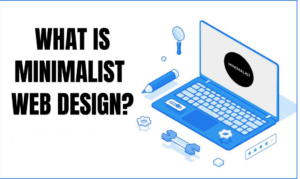The Top Benefits of Minimalist Web Design in 2024:
Introduction
Minimalist web design isn’t just a fleeting trend—it’s a thoughtful philosophy that embraces simplicity, focus, and clarity. With sleek, uncluttered layouts, minimalist websites often outperform their more complex counterparts, offering a smoother and faster experience.
Did you know that 40% of users abandon a website if it takes longer than three seconds to load? This statistic underscores the urgency of optimizing for speed and usability, and it’s one of the many reasons minimalism is taking the web design world by storm.
In this article, we’ll dive into the top benefits of minimalist web design, exploring how it enhances user experience, improves performance, and drives conversions. Ready to find out why “less is more” in web design? Let’s get started!
What is Minimalist Web Design?

Definition of Minimalist Web Design
Minimalist web design is a design approach that focuses on simplicity by eliminating unnecessary elements and content. The goal is to create a clean, straightforward layout that emphasizes essential information and functions.
Key Elements of Minimalist Design
- Limited Color Palettes: Using a few colors allows for a cohesive look that doesn’t overwhelm the user.
- Ample Whitespace: Proper spacing improves readability and makes the content stand out.
- Streamlined Navigation: Simplified menus help users find what they need quickly.
- Essential Elements Only: Including only the most important features keeps the design uncluttered.
Origins and Evolution
Minimalist design has its roots in art and architecture, emerging as a response to the cluttered aesthetics of previous design trends. It has evolved into a popular style in digital design, especially as users increasingly seek clarity and efficiency online.
Read More: 5 Powerful Local Business Advertising Concepts for 2024
Faster Load Times and Improved Performance

Reduced Components to Speed Up Loading
Faster load times are the result of minimalist designs’ intrinsic reduction in components. The amount of time it takes for websites to display content can be greatly decreased by removing bulky images, videos, and scripts.
The Advantages of Quicker Load Times for SEO
Speed is a ranking feature that is given priority by search engines like Google. In addition to improving the user experience, a speedier website increases your visibility in search results, which brings in more natural visitors.
User endurance and load durations
According to statistics, if a page takes more than three seconds to load, 53% of mobile users will go. The importance of speed in retaining users is demonstrated by this startling statistic.
Enhanced User Experience and Focus
Simplified Navigation
Minimalist designs excel in creating simplified navigation paths, which improve usability and engagement. A clear, intuitive menu allows users to find what they need without unnecessary clicks.
Reduced Distractions
By focusing on essential content, minimalist design reduces distractions, allowing users to engage more deeply with the material. This is particularly crucial for businesses looking to communicate important messages without overwhelming visitors.
Consistent User Journey
A minimalist approach fosters a consistent user journey, guiding visitors seamlessly through the website. Intuitive design leads to a better understanding of the brand and encourages users to take desired actions.
Read More: 7 Etsy Alternatives for Creative Sellers
Higher Conversion Rates
Clear Calls-to-Action (CTAs)
In a minimalist design, CTAs stand out prominently, making them easier for users to identify and interact with. The absence of visual clutter means users can focus on taking the desired actions, whether that’s signing up for a newsletter or completing a purchase.
Focused Content Presentation
Minimalist designs allow brands to showcase their products or services without overwhelming visitors. By presenting information clearly and concisely, businesses can effectively communicate their value propositions.
Studies on Minimalist Design and Conversions
Research indicates that websites with minimalist designs see higher conversion rates. For instance, a study by Google found that simplifying a webpage increased conversions by 50%. This demonstrates the power of minimalism in driving user engagement and action.
Improved Mobile Responsiveness
Flexibility in Adjusting to Varying Screen Sizes
Websites with a minimalist design are more responsive by nature. These designs offer a smooth user experience by concentrating on key components that are simple to adapt to desktop and mobile perspectives.
Effect on SEO for Mobile
Having a mobile-friendly design is more important than ever because of Google’s mobile-first indexing. Responsive layouts are a natural fit for minimalist designs, guaranteeing that customers on all devices can effortlessly explore your website.
Effective Minimalist Mobile Design Examples
Companies like Dropbox and Apple are prime examples of minimalist mobile design, putting an emphasis on aesthetics and usability to produce user-friendly experiences.
Read More: 10 Free Google Equipment for Advertising in 2024
Easier Maintenance and Scalability
Easy Maintenance and Updates
Because there are fewer components to manage, websites with minimalist designs are simpler to maintain. This enables a more effective workflow by enabling quick updates.
Combining Minimalist Design with Scalability
Scalability is smooth with minimalist frameworks. The basic layout of the website doesn’t change as new features or material are added, preventing the site from getting cluttered over time.
Long-Term Economical
Lower maintenance expenses are frequently the result of a simple strategy. Businesses can ultimately save time and resources by having fewer components to keep an eye on and update.
Visual Appeal and Branding Benefits
Modern, Timeless Appeal
Minimalist websites tend to have a modern and timeless aesthetic that doesn’t require frequent redesigns. This longevity in design saves businesses from the hassle of constant updates.
Alignment with Brand Values
Many brands are increasingly using minimalism to communicate transparency and clarity. A clean, straightforward design often reflects a brand’s commitment to simplicity and customer focus.
Showcase Examples of Top Brands
Companies like Airbnb and Evernote successfully use minimalist design to reinforce their brand identities, making their platforms approachable and user-friendly.
Read More: 50 Digital Product Concepts Ideas for 2024
The Future of Minimalist Web Design
Forecasts for Minimalist Trends 2024
Future developments in minimalist design should include micro-interactions, monochromatic palettes, and delicate animations that improve user experience without overcrowding the interface.
Minimalism in Relation to SEO and UX
Minimalism will remain consistent with SEO tactics as UX principles change. Both consumers and search engines will choose designs that are straightforward and easy to use, guaranteeing long-term relevance.
The Reasons Minimalism Will Not Go Away
For companies hoping to prosper in a digital environment that prioritizes efficiency and clarity, minimalist web design is a smart option due to its advantages, which include improved user experience, faster loading times, and higher conversion rates.
Conclusion
Minimalist web design is more than just a fad; it’s a strategic approach that enhances user experience, speeds up websites, and increases conversions while preserving consistent branding and ease of maintenance. As the web continues to evolve, minimalism is a smart choice for any website, whether it be personal or business-related, due to its many benefits. Are you ready to embrace the “less is more” philosophy? Now is the time to start redesigning your website for a quicker, cleaner, and more engaging user experience!


